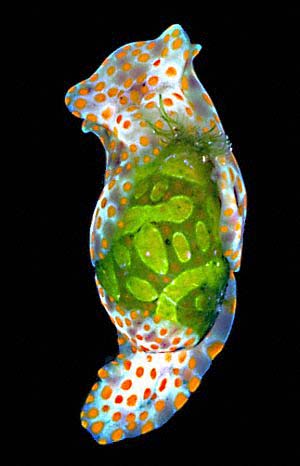
Haminoea cymbalum
(Quoy & Gaimard, 1833)
Order: CEPHALASPIDEA
Superfamily: HAMINOEOIDEA
Family: Haminoeidae
DISTRIBUTION
Found throughout the Indo-West Pacific.
PHOTO
Fingal Bay, Port Stephens, New South Wales, Australia. May 1993. in rock pool, 3 specimens, 23-27mm long alive. - The green on the shell is caused by a fine layer of microscopic green algae. Small tufts of filamentous algae are also growing on the anterior part of the shell. PHOTO: Bill Rudman.
Most species of the Haminoea are translucent with brown, grey and white mottling. Species are found throughout tropical and temperate seas, and often occur in very large populations. Haminoea cymbalum is characterised by the bright orange spots and diffuse purple markings on the translucent greenish body. Sometimes either the orange or purple may be absent but animals are usually clearly identifiable.
All species of Haminoea are herbivorous, grinding their algal food, usually filamentous green species, but sometimes the Sea-lettuce Ulva, or the unicellular algal film which settles on the sandy-mud surfaces on which Haminoea is often found.
See Clay Carlson & Patty Jo Hoff's message below with pictures from Guam and the suggestion that this should be called Haminoea simillima.
Compare with four other orange spotted species, Haminoea ovalis, Haminoea sp. 1., Haminoea sp. 2. and Haminoea sp. 3.
See Carlson & Hoff's message discussing the 5 orange-spotted species.
References:
• Rudman,W.B.,1971. Structure and functioning of the gut in the Bullomorpha (Opisthobranchia). Part 1. Herbivores. Journal of Natural History, 5: 647-675.
• Rudman,W.B.,1971. On the opisthobranch genus Haminoea Turton & Kingston. Pacific Science, 25: 545-559.
Rudman, W.B., 1999 (March 18) Haminoea cymbalum (Quoy & Gaimard, 1833). [In] Sea Slug Forum. Australian Museum, Sydney. Available from http://www.seaslugforum.net/find/hamicymb
Related messages
Mass spawning in Haminoea cymbalum
February 16, 2007
From: Philibert Bidgrain
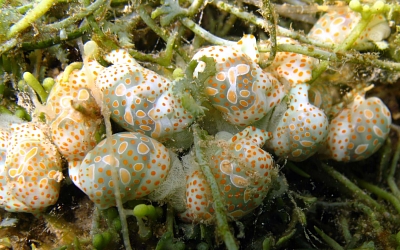
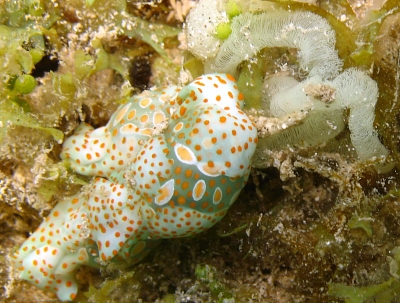
Dear Bill,
In the last few days we observed in the lagoon of Saint Gilles, just near the beach, a phenomenon of mass spawning in Haminoea cymbalum. I found a lot of specimens (between 30 to more than 100 per m2) in several large patches near the beach. Usually we don't observe this species in this area.
Locality: Saint Pierre, 50 cm, Reunion Island, Indian Ocean, 7 February 2007, lagoon. Photographer: Alain Barrére.
I'm very interesting to know if anybody had observed the same comportment in another country. The spawn of this species looks like other Cephalaspidea species
Best regards
Philibert Bidgrain pbidgrain@yahoo.fr http://vieoceane.free.fr/runseaslug/indexslug.htm
pbidgrain@yahoo.fr
Bidgrain, P., 2007 (Feb 16) Mass spawning in Haminoea cymbalum. [Message in] Sea Slug Forum. Australian Museum, Sydney. Available from http://www.seaslugforum.net/find/19447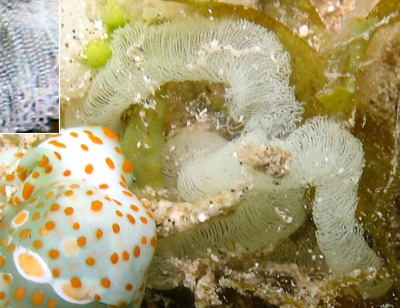 Dear Philibert,
Dear Philibert,It is quite a coincidence that I am posting today a message [#19464] from Scott Cummins about mating aggregations of sea hares. If conditions are good, many cephalaspideans, like the anaspideans, can quickly dvelop large local populations. Paul Furneaux's message [#11626] about H. zealandiae in New Zealand shows such an occurrence, but my experience in New Zealand is that while at times great mass mating events occurred, most years their behaviour was much more restrained.
Best wishes,
Bill Rudman Rudman, W.B., 2007 (Feb 16). Comment on Mass spawning in Haminoea cymbalum by Philibert Bidgrain. [Message in] Sea Slug Forum. Australian Museum, Sydney. Available from http://www.seaslugforum.net/find/19447
Haminoea cymbalum from the Cook Islands
May 26, 2006
From: Marcus Coltro
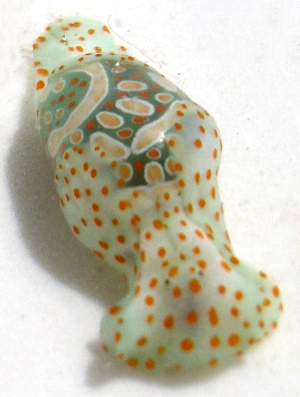
I collected these small and beautiful Haloa (I hope I got to the right genus) in Aitutaki, Cook Islands.
I found several on a coral head at 1 meter - and although there were several coral heads containing exactly the same algae on it I only found these shells on one place only.
Any suggestions?
Locality: Aitutaki, 1 meter, Cook Islands, South Pacific, 07 April 2006, On coral head feeding on algae. Length: 6 to 8 mm. Photographer: Marcus Coltro.
Marcus Coltro.
shells@femorale.com.br
Coltro, M.V., 2006 (May 26) Haminoea cymbalum from the Cook Islands. [Message in] Sea Slug Forum. Australian Museum, Sydney. Available from http://www.seaslugforum.net/find/16664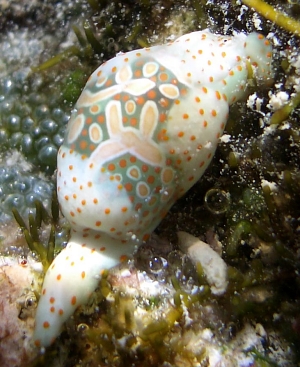
Dear Marcus,
Many years ago (Rudman, 1971) I suggested that there were no anatomical grounds to separate the genus Haloa from Haminoea. I have identified this animal as Haminoea cymbalum but Clay Carlson & Patty Jo Hoff [see message #709 ] suggest that that species is unidentifiable and we should use the name Haminoea simillima.
Why you will sometimes find opisthobranchs in one spot and not in an equally desirable spot elsewhere, is one of lifes' little mysteries. If I could have a dollar for everytime I have said "this is just the place to find species x" and found nothing, I would be a very rich man.
Best wishes,
Bill Rudman
Trailing in Haminoea cymbalum from Reunion Island
October 18, 2005
From: Philibert Bidgrain
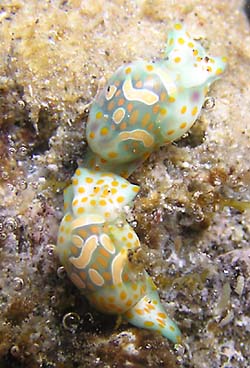
Dear Bill,
Reunion Island sea slugs.
A week ago, we found in permanent shallow pools on the rocky reef of Etang salé les bains, a great number of this sea slug. I see a lot of specimens, having this characteristic behavior of trailing in pairs on the substrate and on the seaweed.
Locality: Etang Sale. Reunion Island. Indian Ocean. Depth: 10 cm. Length: 10-15 mm. October 2005.permanent pools Photographer: Philibert Bidgrain
Best Regards
Philibert Bidgrain
http://vieoceane.free.fr/runseaslug/indexslug.htm
vieoceane@free.fr
Bidgrain, P., 2005 (Oct 18) Trailing in Haminoea cymbalum from Reunion Island. [Message in] Sea Slug Forum. Australian Museum, Sydney. Available from http://www.seaslugforum.net/find/15023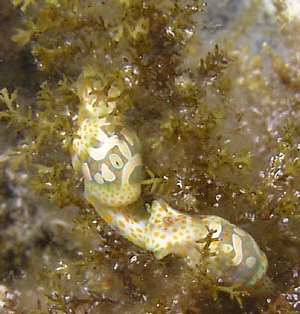
Dear Philibert,
Thanks for this. 'Trailing appears to be a pretty wide spresd phenomenon in the opisthobranchs. By coincidence I posted a message recently on Haminoea cyanomarginata [#15015], showing its own version of trailing.
Best wishes,
Bill Rudman
Haminoea cymbalum from Christmas Island
May 8, 2002
From: W.B. Rudman
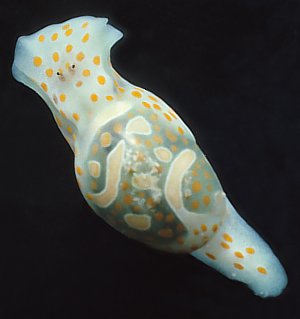
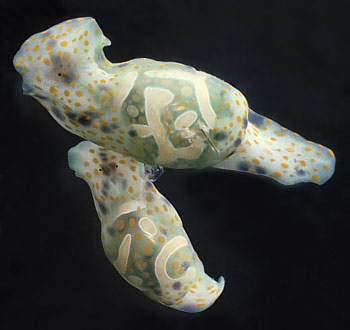
Here is some information and photos on Haminoea cymbalum from John Hicks' Christmas Island, Indian Ocean collections.
PHOTOs:
UPPER: AM C127020, 1 February 1981, Ethel Beach, under coral rock in intertidal zone, 12 mm long alive.Christmas Is., Indian Ocean. Photo: John Hicks
LOWER: AM C127474, 21 April 1981, off boat ramp, Christmas Is., Indian Ocean. Photo: John Hicks
Best wishes,
Bill Rudman
Haminoea? from the Philippines
June 14, 2001
From: Erwin Köhler
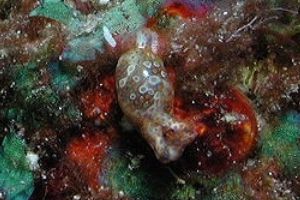
Dear Bill,
Here is the next one from the Philippines, Cebu Island, Moalboal. Length 2-3 mm, 8 m depth, May 28, 2001, divesite "Umbrella".
Erwin
Erwin@medslugs.de
Köhler, E., 2001 (Jun 14) Haminoea? from the Philippines. [Message in] Sea Slug Forum. Australian Museum, Sydney. Available from http://www.seaslugforum.net/find/4556Dear Erwin,
Before Clay Carlson alerted me to how many orange-spotted species of Haminoea there were I would have just called this Haminoea cymbalum. I think I will wait for his comments.
Best wishes,
Bill Rudman
Sesquiterpene molecule from Haminoea cymbalum
April 15, 2001
From: Brett Baker
I need to know the molecular formula and structure of the biosynthetic precursor that will produce the chemical agent, "kumepaloxane" which is discharged by the Haminoea cymbalum slug.
Can anyone help?
Brett
brettsbaker@aol.com
Baker, B., 2001 (Apr 15) Sesquiterpene molecule from Haminoea cymbalum. [Message in] Sea Slug Forum. Australian Museum, Sydney. Available from http://www.seaslugforum.net/find/4182Dear Brett,
I only know of the original reference:
Poiner, A. Paul, V.J. & Scheuer, P.J. (1989) Kumepaloxane, a rearranged trisnor sesquiterpene from the bubble-shell Haminoea cymbalum. Tetrahedron, 45(3): 617-22
The molecule is perhaps an antifeedant chemical produced by the slug, which makes the slug distasteful to predators.
Best wishes,
Bill Rudman
Haminoea cymbalum in southern Queensland
June 29, 2000
From: John Bodman
Hi
I to am interested in keeping Haminoea cymbalum in a reef set up. It contains many algae species and a thriving community of sacoglossans. I live in Brisbane and would like to find out if they can be collected somewhere locally as far as a day trip. Any information would be greatfully received.
John
bodmanwishbug@dingoblue.com.au
Bodman, J., 2000 (Jun 29) Haminoea cymbalum in southern Queensland. [Message in] Sea Slug Forum. Australian Museum, Sydney. Available from http://www.seaslugforum.net/find/2431Dear John,
I'm afraid I have no local knowledge on where you would find H. cymbalum around Brisbane. Species of Haminoea are often found on sheltered sand or sandy-mud shores but they are also found on rocky reefs, or coral reef flats. In fact the few times I have found H. cymbalum around Sydney it has been on intertidal rock platforms.
I'm sorry to say that sea slugs as a group are not the easiest animals to collect on demand. Even the most common species will disappear just when you need a few, and will not appear again for months.
I am interested in your mention of keeping sacoglossans alive in your aquarium. Do you know what species you have?
Best wishes,
Bill Rudman.
Re: Haminoea cymbalum in aquaria
August 19, 1999
From: Nathan Cope
Thanks for that Bill. I went to a presentation by Clay about 6 - 9 months ago at Underwater World here in Perth and he was actually giving a talk on Nudibranchs, so I don't know why I didn't even think of him. I'll give him a call.
Thanks for your help,
Nathan Cope.
copen@one.net.au
Cope, N., 1999 (Aug 19) Re: Haminoea cymbalum in aquaria. [Message in] Sea Slug Forum. Australian Museum, Sydney. Available from http://www.seaslugforum.net/find/1218Keeping Haminoea cymbalum in aquaria
August 17, 1999
From: Nathan Cope
Dear Dr Rudman,
I've seen Haminoea cymbalum on the Australian Museum web site and a photo of it accredited to you. I'm hoping that you will be able to supply me with some more information about the species.
I am a marine "reef" hobbyist and am interested in keeping some of these animals, but I would like to find out if they will be viable in my aquarium before I go ahead and try them. If not, I would still like to be able to see them in the wild.
What I'm particularly interested in is breeding habits and life cycle, food requirements and likely locations that these animals can be found around the country - I see that at least one specimen was from NSW.
Thankyou for any help you can offer,
Nathan Cope
Perth,
Western Australia.
copen@one.net.au
Cope, N., 1999 (Aug 17) Keeping Haminoea cymbalum in aquaria. [Message in] Sea Slug Forum. Australian Museum, Sydney. Available from http://www.seaslugforum.net/find/1203Dear Nathan,
I think it would be a good idea to try an animal like Haminoea cymbalum in an aquaria. Probably a lot easier than most nudibranchs which feed on a variety of animals (often colonial) which are htemselves difficult to keep alive.
I am not sure what algae H. cymbalum eats. Clay Bryce in an earlier message, suggested the red algae Laurencia which would be worth a try, but I suspect it could be tempted with common filamentous green algae or even the algal film that grows on aquarium glass, rocks etc. Certainly I have found species of Haminoea easy to keep in aquaria on green algae like Ulva (sea lettuce) and Enteromorpha but it may be that H. cymbalum has a more specialised diet.
Where would you find it? Although tropical, it is certainly often a common visitor as far south on the Australian east coast as Sydney. In Western Australia it has only been reported from the Dampier Archipelago [Wells, F.D. & Bryce, C.W. (1993) Sea Slugs of Western Australia. Western Australian Museum: Perth], but as many tropical animals are found, at times, much further south in Western Australia, I wouldn't give up hope of fuinding it nearer to your home. species of Haminoea are often found on sheltered sand and mudflats, but H. cymbalum is often found on intertidal rock platforms, in shallow pools.
They probably live for about a year, and lay sausage egg masses containing many tiny eggs which hatch as free-swimming larvae. You would need to replace ypur animals each year as breeding them in captivity is very difficult.
Give Clay Bryce at the Western Australian Museum, Perth, a ring. He may be able to give you some ideas.
Best wishes,
Bill Rudman.
Food of Haminoea cymbalum
March 24, 1999
From: Clay Carlson
Dear Bill,
My note on the possible host for H. cymbalum [the red algae, Laurencia], came from: Poiner, Paul & Scheuer,1989. Kumepaloxane, a rearranged trisnor sesquiterpene from the bubble shell Haminoea cymbalum. Tetrahedron, 45(3):617-622.
Clay.
clay.carlson@kuentos.guam.net
Carlson, C. & Hoff, P.J., 1999 (Mar 24) Food of Haminoea cymbalum. [Message in] Sea Slug Forum. Australian Museum, Sydney. Available from http://www.seaslugforum.net/find/717Re: Haminoea cymbalum & H. simillima
March 21, 1999
From: C. Carlson & P.J. Hoff
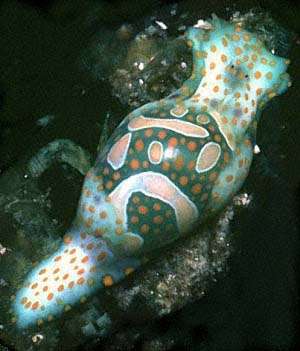
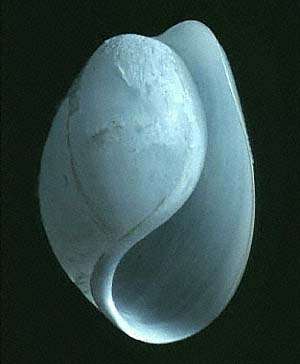
Bill,
Here is a partial response to the three animals in the 'cymbalum' discussion. I will send this in three parts. We believe that Lindsay's 78 & 79 are separate species and have included some material from specimens found on Guam. Haminoea cymbalum has been fairly consistent in its color pattern when we have found it. It is easily separable from the other orange spotted specimens in our collection by the nature of it's gizzard
plates as well as color. The gizzard plates of H. cymbalum are relatively smooth with a hint of a series of ridges but lacking the high profile ridges as well as the heavy concentrations of chitinous rods found in both '78' & '79'.
There is a problem with the identification 'cymbalum'. It is difficult to tell from Quoy & Gaimard's original drawing which one of the many rotund shells was being shown. The specimen in the Paris Museum that represents Q & G's 'cymbalum' is much larger than what Q & G described. It has been suggested that the shell of H. navicula (da Costa, 1778) was substituted. The earliest name we feel represents 'cymbalum' is H. simillima Pease, 1868.
A possible host for H. simillima is the red algae, Laurencia, in which it is often found.
UPPER PHOTO: Guam, Bile Bay, reef flat; 12.5mm long; 25 Oct. 1976. LOWER PHOTO: Shell, 8.5 x 5.0mm
Clay & Patty Jo
Clay Carlson & Patty Jo Hoff
Merizo, Guam.
clay.carlson@kuentos.guam.net
Carlson, C. & Hoff, P.J., 1999 (Mar 21) Re: Haminoea cymbalum & H. simillima. [Message in] Sea Slug Forum. Australian Museum, Sydney. Available from http://www.seaslugforum.net/find/709Dear Clay & Patty Jo,
Thanks for your contribution. I hoped you would see my request for help. It's many years since I looked inside a Haminoea, but I remember finding the penis morphology to be a good species character. I have seen specimens of what I call H. cymbalum from Australia, Fiji, India and East Africa. I will need to have a look at my drawings etc to sort out what I had.
I have continued using 'cymbalum' at this moment, not because I disagree with you on simillima, but through a prudent inertia. I'll see if anyone else joins the debate before changing filenames, indices etc.
Best wishes,
Bill Rudman.
Haminoea cymbalum? from Sulawesi
March 18, 1999
From: Lindsay Warren
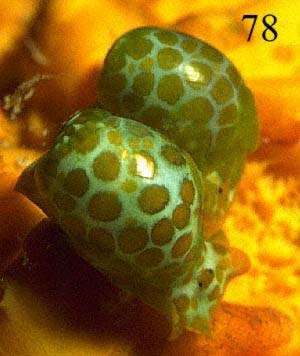
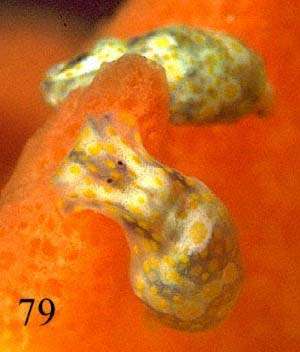
Dear Bill
Please find attached further opisthobranchs found in the Tukang Besi Islands, [Sulawesi, Indonesia - Operation Wallacea ] last year:
#78 - Length: 9 mm. White shell with orange spots. Mantle orange with white spots and orange spots. White centre to posterior foot. They were found on dead branching coral which was covered in algae.
#79 - Length: 8 mm. Internal shell different from OWN78 with white blotches with orange centre. Mantle with small orange spots. White centre to posterior foot from shell to end of foot surrounded by transparent
mantle with a few orange spots. They were found on dead branching coral which was covered in algae.
My feeling is that they are both Haminoea cymbalum although there were some distinct differences.
If you would like the illustrations emailed through, please let me know. Looking forward to hearing your comments.
All the best
Lindsay
100014.2112@compuserve.com
Warren, L., 1999 (Mar 18) Haminoea cymbalum? from Sulawesi. [Message in] Sea Slug Forum. Australian Museum, Sydney. Available from http://www.seaslugforum.net/find/691Dear Lindsay,
Yes I think they are both H. cymbalum. It seems to vary in colour quite considerably, some animals having no purple, others with small purple spots, and others with large diffuse purple patches. The orange and green also varies. Anyone else's comments are very welcome.
Bill Rudman.
